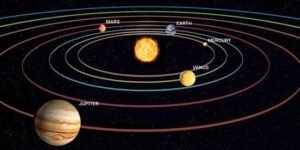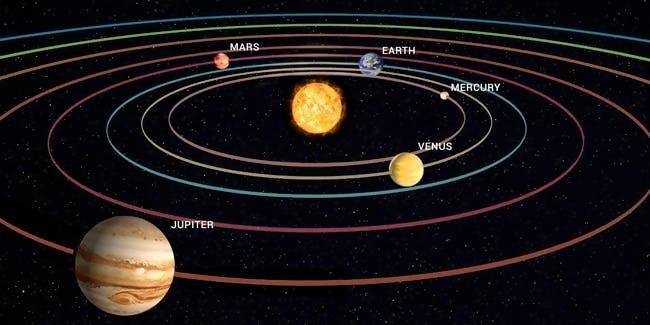What Is The Distance Between Jupiter And The Sun: The vastness of our solar system is home to many celestial wonders, one of which is the astounding testament to cosmic scales that is the distance between Jupiter and the Sun. Jupiter, the gas giant with its captivating bands of clouds, lies tucked away beyond the asteroid belt and circles our bright star at an incredible distance. This astronomical distance is more than just a number; it is a cosmic dance that characterizes the dynamics of our neighborhood in space.
Jupiter is the largest planet in our solar system, and its orbit around the Sun stretches farther than most people could ever imagine. Investigating the complexities of this enormous region reveals the enormous distances that celestial bodies travel as well as the gravitational forces that bind our solar family members together. The distance between Jupiter and the Sun becomes a celestial thread that weaves the story of cosmic marvel, so let’s go on a voyage through the celestial tapestry.

Quick Navigation
Examination of the Distance Between Jupiter and the Sun
The separation between Jupiter and the Sun becomes a celestial measuring stick in the immensity of our solar system, a cosmic metric that influences the dynamics of our planetary neighborhood. This paper takes the reader on a voyage through the complexities of this celestial event, delving into its numerical magnitudes, relative importance, orbital subtleties, temporal dimensions, measuring techniques, and the significant effects on Jupiter’s atmospheric ballet.
Using the Average Distance Between Jupiter and the Sun to Define the Cosmic Yardstick
Jupiter, a gas giant that orbits the Sun at an average distance of 5.2 astronomical units, sits at the center of our solar system. It’s important to realize that one astronomical unit is the mean distance, or roughly 93 million miles or 150 million kilometers, between Earth and the Sun in order to appreciate the magnitude of this number. Jupiter is positioned far from our star, providing us with a vast area of space that makes the gas giant appear enormous in our galaxy.
Comparative Lengths: Jupiter’s Position in the Solar Symphony
The distance between Jupiter and the Sun determines the tone of this gas giant’s heavenly music. Each planet contributes a different note to the cosmic orchestra. Jupiter is classified as an outer giant because its orbit goes beyond the asteroid belt, unlike the rocky inner planets like Mercury, Venus, Earth, and Mars.
Jupiter, an outer planet, arranges a magnificent dance over a larger cosmic stage than the inner planets, which dance closer to the Sun and have shorter orbital periods. So, the separation between Jupiter and the Sun provides a reference point, demonstrating the various sizes that control our solar system.
Read Also: Top Volunteer Programs in Saudi Arabia
Variations in the Distance Between Jupiter and the Sun: Dynamic Dances
The eccentric orbit of Jupiter introduces dynamic fluctuations in the distance between the gas giant and the Sun because it is not a complete circle. As Jupiter follows its elliptical path, it moves toward the Sun during its perihelion, or point of closest approach, and away from it at its aphelion, or farthest point.
These differences are gravitational choreographies determined by Newton’s gravitational force and Kepler’s laws, not just subtle numerical differences. An interesting variable in the story of celestial dynamics is the separation between Jupiter and the Sun.
Understanding Jupiter’s Orbital Timescale with the Jovian Years
Jupiter’s orbit around the Sun is a planetary trip that takes around 11.86 Earth years to complete. The reason for this long orbital period is Jupiter’s large separation from the Sun. Jupiter’s regal journey symbolizes the vast scope of the outer reaches of our solar system, whilst the inner planets finish their circles in a fraction of this time. In this sense, the separation between Jupiter and the Sun becomes a measure of time, indicating the passing of Jovian years in cosmic histories.
Measuring the Distance Between Jupiter and the Sun Using Accurate Instruments
Calculating the exact distance between Jupiter and the Sun requires sophisticated astronomy instruments and techniques. One such technique is radar ranging, which uses radio waves to gauge how long it takes for messages to reach Jupiter and return. Another method for calculating distances is to use parallax, which is the apparent change in Jupiter’s position relative to the background stars as seen from Earth. (21).
In addition, space missions and robotic probes fitted with advanced instrumentation provide important information that advances our knowledge of the astronomical distance between Jupiter and the Sun. These technological wonders increase our understanding of the cosmos by converting the abstract concept of distance into concrete measures.
Read Also: 7 best medical schools in France for international students
Cosmic Influences: How Jupiter’s Atmosphere Is Affected by Distance
Not only is the distance between Jupiter and the Sun a spatial measure, but it also plays a significant role in defining the gas giant’s atmospheric characteristics. Jupiter receives a lot less solar energy per unit area than the inner planets because it is located far from the Sun. The variation in energy input is essential in shaping the atmospheric properties of Jupiter.
The Great Red Spot, the turbulent storms, and the recognizable bands of clouds are examples of how Jupiter’s atmospheric dynamics and its distance from the Sun interact intricately. The distance takes on the role of a cosmic puppeteer, directing massive atmospheric phenomena.
Additionally:
The distance between Jupiter and the Sun appears like a thread woven into our celestial narrative as we go into the cosmic abyss. It is not just a number; rather, it is a cosmic parameter that affects measurements, time intervals, dynamics, scales, and atmospheric phenomena.
The gas giant invites us to reflect on the grandeur and complexity that characterize the relationships between celestial bodies as it stands sentinel in the outer reaches of our solar system. We traverse the cosmic dance that forms our view of the cosmos by solving the secrets contained in the space between Jupiter and the Sun.
What is the mean astronomical distance in units of distance between Jupiter and the Sun?
Astronomical units (AU), or the mean distance between Jupiter and the Sun, are a fundamental unit of measurement used to quantify the size of our solar system. The mean distance between Earth and the Sun, which is roughly 93 million miles or 150 million kilometers, is known as an astronomical unit. Jupiter has an average distance of roughly 5.2 astronomical units, making it the fifth planet from the Sun. This positions Jupiter far from our burning star and emphasizes the vast spatial scale that determines the positions of planets in our solar system.
Read Also: 5 Best Universities for Engineering in London
In relation to the other planets in our solar system, what is the difference in distance between Jupiter and the Sun?
When comparing the planetary groupings in the grand cosmic tapestry, the distance between Jupiter and the Sun is a crucial point of comparison. Jupiter is beyond the terrestrial planets Earth, Mars, and Venus due to its large orbit, although Mercury, the planet nearest to the Sun, is just 0.39 AU away.
The outer giants, such as Saturn, Uranus, and Neptune, are closer to the gas giant than they are to the inner planets. The distance between Jupiter and the Sun, then, serves as a celestial yardstick that provides insight into the variety of spatial architectures that characterize our solar neighborhood.
During Jupiter’s elliptical orbit, what variables affect the changes in the distance between Jupiter and the Sun?
Jupiter travels an irregular orbit around the Sun rather than a complete circle. Variations in the distance between Jupiter and the Sun during its orbit are caused by this ellipticity. These fluctuations are caused by the gravitational forces at work, which are mainly controlled by Kepler’s laws and Newton’s law of universal gravitation.
The distance varies dynamically as Jupiter moves toward the Sun during its perihelion and away from it at its aphelion. The comprehension of the distance between Jupiter and the Sun is further complicated by the dynamic interaction of elliptical orbits and gravitational forces.
Given its great distance from the Sun, how long does Jupiter take to complete one orbit?
Astronomically speaking, Jupiter’s orbit around the Sun is a marathon; the gas giant completes one orbit, or a Jovian year, in about 11.86 Earth years. Jupiter’s distance from the Sun directly contributes to this longer timescale. The outer planets, like Jupiter, have longer, more magnificent orbits than the closer planets to the Sun, which have shorter orbital periods as a result of their proximity. Jupiter’s orbital cycle is quite long, which emphasizes the enormous scales governing the solar system’s celestial mechanics.

How exactly do astronomers measure and analyze the distance between Jupiter and the Sun? What tools and techniques do they employ?
This distance between Jupiter and the Sun can only be measured with advanced astronomical methods and state-of-the-art equipment. A straightforward way to measure distances is using radar ranging, which involves bouncing radio waves off planets and timing how long it takes for the signals to return.
Astronomers can also determine distances by using parallax, which is the observation of Jupiter’s apparent movement in position relative to the background stars as seen from Earth. The dynamic relationship captured in the distance between Jupiter and the Sun is also better understood because to the crucial data provided by space missions and robotic probes outfitted with cutting-edge instrumentation.
Because of its distance from the Sun, does Jupiter’s atmosphere or behavior suffer any major repercussions or effects?
Not only does the distance between Jupiter and the Sun determine the planet’s coordinates in space, but it also significantly influences its atmospheric and behavioral features. Jupiter receives a lot less solar energy per unit area than the inner planets because of its considerable distance from the sun.
The gas giant’s unique atmospheric dynamics, which include the recognizable Great Red Spot and noticeable bands of clouds, are influenced by this variation in solar input. The distance between Jupiter and the Sun is a crucial aspect in solving the mysteries of the gas giant’s fascinating features because the energy balance, which is controlled by the distance, sets the stage for complex atmospheric processes.
Recommended:
- 12 Best Computer Science Universities in Europe
- 7 Cheap Universities in Ontario
- VUT Blackboard Login | Vaal University of Technology
- Shih Chien University – Scholarships, Ranking, Courses & Tuition
Additionally:
Our cosmic story revolves around the distance between Jupiter and the Sun, which combines concepts of measurement, dynamics, scale, comparison, and effect. It acts as a cosmic yardstick, directing our stargazing and encouraging us to ponder the grandeur and complexity that characterize the relationships between the celestial bodies in our solar system.
SEE ALSO:
Trust you found our article on What Is The Distance Between Jupiter And The Sun helpful. Follow our website for more interesting articles.

